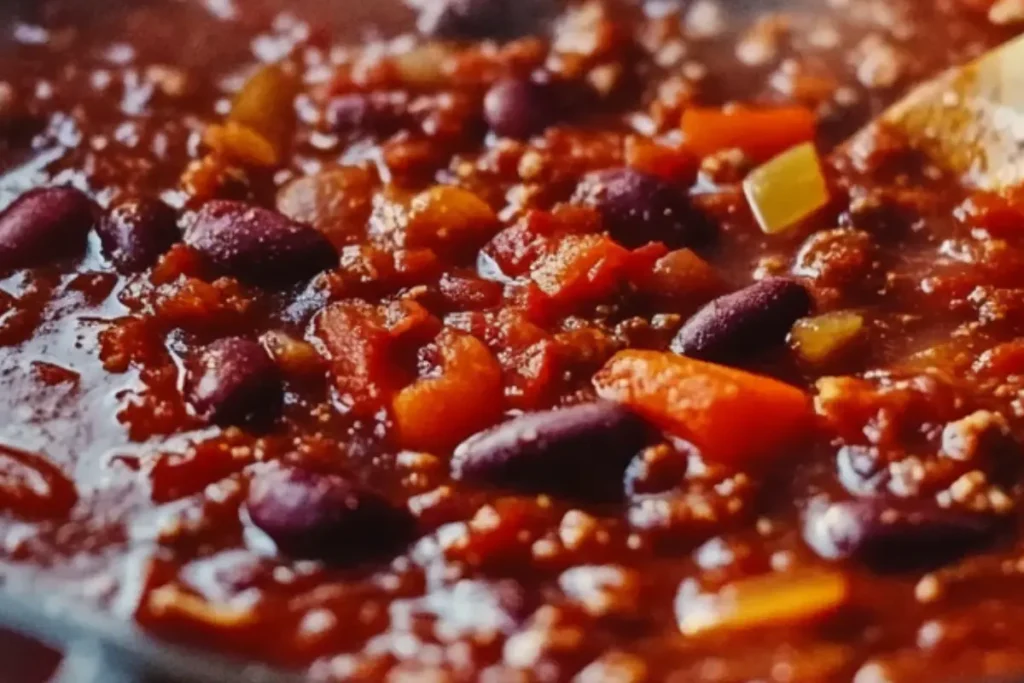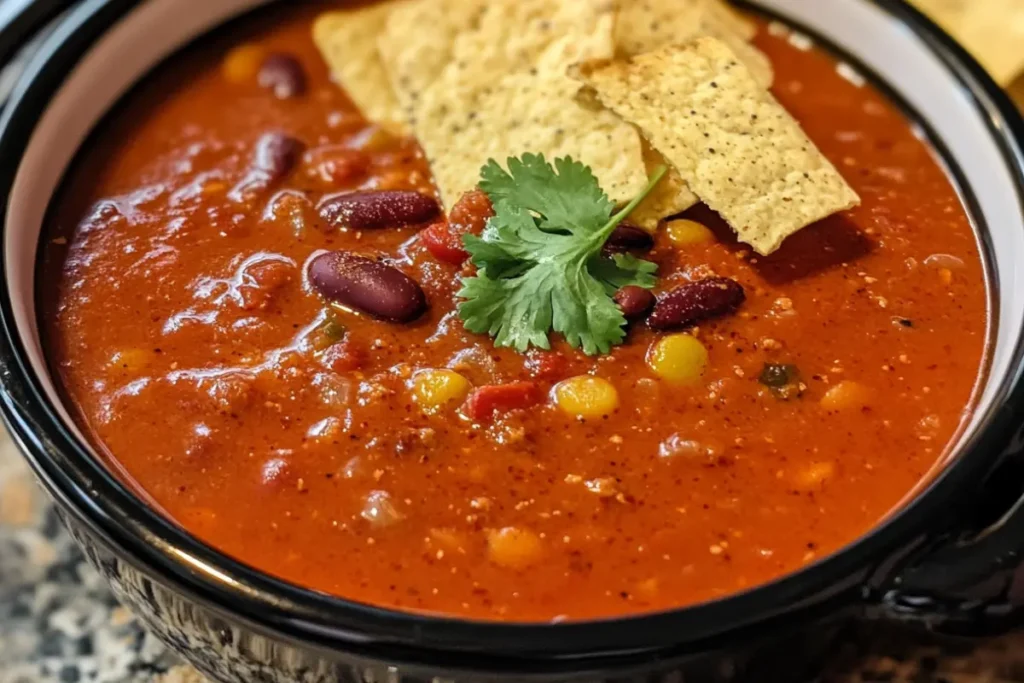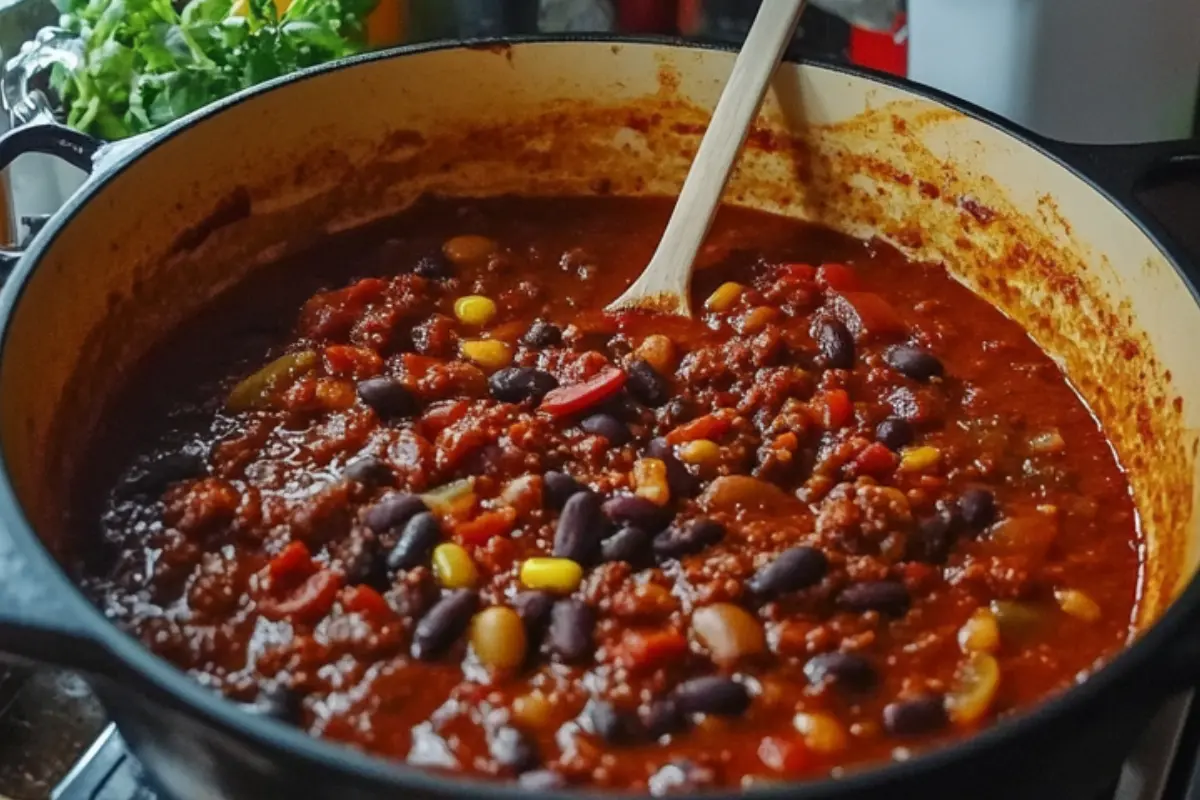The question, is chili a soup?, has sparked countless debates among food enthusiasts, home cooks, and even culinary experts. It’s a question that delves into the very essence of what defines a soup and whether chili, in all its hearty and robust glory, fits within those boundaries. Therefore, let’s embark on a flavorful journey to explore this culinary conundrum and determine if chili deserves a place in the soup category.
Table of Contents
Defining Soup: What Makes a Soup a Soup?
To answer the question, is chili a soup?, we must first establish a clear understanding of what constitutes a soup. Generally, soup is defined as a primarily liquid food, typically served warm or hot (but sometimes cold), that is made by combining ingredients such as meat or vegetables with stock, juice, water, or another liquid. Furthermore, soups are often characterized by their broth, which acts as the flavorful base, and the presence of solid ingredients that are either simmered until tender or added for texture and flavor.
Several key characteristics commonly define soup:
- Liquid Base: A defining feature of soup is its liquid base, which can range from thin and brothy to thick and creamy. This liquid is crucial for carrying flavors and providing the characteristic soup texture.
- Broth or Stock: Often, a flavorful broth or stock forms the foundation of a soup. This broth can be made from bones, meat, vegetables, or a combination thereof, adding depth and richness to the final dish.
- Simmering Method: Soup is typically prepared using a simmering method, allowing flavors to meld and ingredients to soften and release their essence into the liquid.
- Versatility of Ingredients: Soup is incredibly versatile, accommodating a wide array of ingredients. Vegetables, meats, legumes, grains, and pasta are all common additions, allowing for endless variations and flavor profiles.
- Served in a Bowl: Traditionally, soup is served in a bowl and eaten with a spoon, further reinforcing its liquid-based nature.
However, the definition of soup is not always rigid. Culinary boundaries can be fluid, and many dishes blur the lines between soup, stew, and other categories. Therefore, understanding these core characteristics helps us approach the question, is chili a soup?, with a more informed perspective.
Defining Chili: More Than Just a Bowl of Red?
Now, let’s turn our attention to chili, a dish with a rich history and passionate following. Chili, often specifically chili con carne (chili with meat), is a hearty and flavorful dish that originated in Texas in the 19th century. It is characterized by its robust flavors, often featuring chili peppers, meat (typically beef), tomatoes, beans (though beans in chili are a point of contention for some purists), and a blend of spices.
Key characteristics of chili include:
- Hearty and Robust Flavor: Chili is known for its bold and intense flavors, derived from chili peppers, spices like cumin and chili powder, and the slow cooking process that allows flavors to deepen.
- Thick Consistency: Compared to many soups, chili typically has a much thicker consistency. This thickness comes from the ingredients and the long simmering time, which reduces the liquid and concentrates the flavors.
- Meat-Centric (Traditionally): While vegetarian and vegan chili variations exist, traditional chili con carne is meat-centric, with beef often being the star ingredient.
- Spice and Heat: Chili often incorporates chili peppers, which contribute varying degrees of spice and heat. This spiciness is a defining characteristic for many chili enthusiasts.
- Toppings and Garnishes: Chili is frequently served with toppings like shredded cheese, sour cream, onions, cilantro, or tortilla chips, enhancing its flavor and texture profile.
However, similar to soup, chili also exhibits variations. From Texas-style chili (often without beans) to chili verde (green chili) and vegetarian chili, the dish encompasses a range of styles and ingredients. This diversity makes the question, is chili a soup?, even more intriguing.
Chili vs. Soup: Comparing and Contrasting the Culinary Cousins
When we place chili and soup side-by-side, we can observe both similarities and differences that contribute to the ongoing debate, is chili a soup?
Similarities:
- Simmered Dish: Both chili and soup are typically prepared through simmering, a cooking method that allows flavors to develop and ingredients to become tender. This slow cooking process is fundamental to both culinary creations.
- Combination of Ingredients: Both chili and soup involve combining various ingredients, including vegetables, meats, and spices. This versatility in ingredients is a hallmark of both dishes.
- Served Warm: Both chili and soup are predominantly served warm, particularly in colder months, offering comfort and nourishment. This shared serving temperature contributes to their perception as comforting meals.
- Can be Hearty and Filling: Both chili and soup can be crafted to be hearty and filling meals, suitable for lunch or dinner. Ingredients like meat, beans, and vegetables contribute to their substantial nature.
- Bowl-Based Serving: Both are commonly served in bowls, further blurring the lines in terms of presentation and consumption. This shared serving vessel adds to the confusion surrounding is chili a soup?.
Differences:
- Consistency: The most noticeable difference often lies in consistency. Soup tends to be more liquid and brothy, while chili is typically much thicker and denser. This textural distinction is a key point in the is chili a soup? debate.
- Broth Prominence: In soup, the broth is often a central element, providing a significant portion of the flavor and volume. In chili, while liquid is present, it is less prominent, and the focus is more on the solid ingredients and their concentrated flavors.
- Meat-to-Vegetable Ratio: Traditional chili, especially chili con carne, often has a higher meat-to-vegetable ratio compared to many soups. This meat-centric nature sets it apart from vegetable-heavy soups.
- Spice Profile: Chili typically boasts a bolder and spicier flavor profile, largely due to the inclusion of chili peppers and specific spices like cumin and chili powder. Soup flavor profiles are more diverse and can range from mild to intensely flavored, but not always with the same level of spice as chili.
- Serving Style and Garnishes: While both are served in bowls, chili often features more elaborate toppings and garnishes than typical soups. These additions are integral to the chili experience, whereas soup garnishes are often simpler.
Therefore, these comparisons highlight that while chili and soup share some fundamental characteristics, they also diverge in significant ways, fueling the debate surrounding is chili a soup?.

Arguments for Chili Being a Soup: Broth, Ingredients, and Cooking Method
Those who argue that chili is a soup often point to several key factors that align chili with the definition of soup.
- It Has a Liquid Base: Despite its thickness, chili undeniably has a liquid component. This liquid, whether it’s tomato-based, broth-based, or water-based, serves as a medium for cooking the ingredients and carrying the flavors, much like the broth in soup. Therefore, the presence of a liquid base is a primary argument for chili being considered a soup. Furthermore, while the liquid may be reduced and thickened, it remains a crucial component of the dish.
- It Contains Soup Ingredients: Chili often includes ingredients commonly found in soups, such as vegetables (onions, peppers, tomatoes), meat (beef, pork, chicken), and sometimes beans and legumes. These ingredients are simmered together, similar to how soup ingredients are cooked. In addition, the inclusion of these typical soup components strengthens the argument for chili belonging to the soup family. For example, many vegetable soups share similar ingredient profiles with chili, just with a higher liquid ratio.
- It’s Cooked Like a Soup: The cooking method for chili, simmering, is a hallmark of soup preparation. Ingredients are combined and gently cooked over time, allowing flavors to meld and deepen. This slow simmering process is consistent with how many soups are made. Therefore, the shared cooking technique further supports the idea that chili is a soup. Moreover, the goal in both chili and soup preparation is to create a harmonious blend of flavors through simmering.
- Cultural and Regional Variations: In some cultures and regions, dishes very similar to chili might be readily classified as soups. Culinary classifications can be influenced by regional traditions and linguistic nuances. Therefore, what might be considered chili in one region could be seen as a hearty soup in another. In addition, the lines between soup and stew are already blurred in many cuisines, and chili could be seen as falling into this gray area.
However, while these points make a compelling case, there are equally strong arguments on the other side of the debate.
Arguments Against Chili Being a Soup: Thickness, Meat Content, and Culinary Identity
Conversely, those who argue against chili being classified as soup emphasize its distinct characteristics that set it apart.
- Its Thickness is Too Substantial: The most common argument against chili being soup is its thick, stew-like consistency. Traditional soup is generally expected to be more liquid and brothy. Chili‘s density, often achieved through a higher ratio of solids to liquids and longer simmering times, deviates significantly from the typical soup texture. Therefore, this textural difference is a primary reason why many do not consider chili a soup. Furthermore, the thickness often makes chili feel more like a main course stew than a lighter soup.
- It’s Often Meat-Heavy: Traditional chili con carne is heavily reliant on meat, often beef, as the central ingredient. While soups can contain meat, they often feature a more balanced ratio of meat to vegetables and broth. The meat-centric nature of chili sets it apart from many vegetable-forward or broth-based soups. In addition, the prominent role of meat in chili contributes to its heartier and more substantial character, unlike many soups that are lighter and more broth-focused.
- Culinary Identity and Perception: Chili has developed its own distinct culinary identity and is rarely referred to as soup in common parlance. People order “a bowl of chili,” not “a bowl of chili soup.” This linguistic and cultural distinction highlights how chili is perceived as a separate category from soup. Therefore, the established culinary identity of chili as its own dish is a strong argument against classifying it as merely a type of soup. Moreover, cookbooks and restaurant menus typically categorize chili separately from soups, further solidifying this distinction.
- Purpose and Usage: Soup is often served as a starter or a lighter meal, while chili is frequently considered a main course, especially due to its heartiness and substantiality. This difference in typical usage further separates chili from the general perception of soup. In addition, chili‘s richness and density make it a satisfying and complete meal on its own, whereas soup is often complemented by other dishes to form a full meal.
However, these counter-arguments, while strong, do not definitively settle the debate. The line between soup and chili remains blurry.
Legal and Culinary Classifications: Does it Matter?
The debate about is chili a soup? extends beyond casual kitchen discussions. Interestingly, there have even been legal and culinary classification attempts to define these dishes.
- Legal Definitions: In some legal contexts, especially concerning food labeling or competitions, attempts have been made to define soup and chili more formally. These definitions often focus on factors like viscosity, ingredient ratios, and intended use. However, legal definitions can be rigid and may not always align with culinary perceptions. Therefore, while legal classifications exist, they don’t necessarily resolve the culinary debate definitively. Furthermore, legal definitions can vary across jurisdictions, adding to the complexity.
- Culinary Organizations: Culinary organizations and competitions often have their own guidelines for categorizing dishes like soup and chili. These guidelines might be more nuanced than legal definitions, taking into account culinary traditions and flavor profiles. However, even within the culinary world, opinions can vary, and there is no universal consensus on whether chili is a soup. In addition, culinary competitions often have specific categories for chili and soup, suggesting a distinction, but this might be for organizational purposes rather than a definitive classification.
- Dictionary Definitions: Dictionary definitions of soup often emphasize the liquid base and simmering method, which could arguably include chili. However, these definitions are broad and can be interpreted in different ways. Therefore, dictionary definitions provide a starting point but don’t offer a conclusive answer to the question, is chili a soup?. Moreover, dictionaries aim to reflect common usage, which, as we’ve seen, is divided on this issue.
Ultimately, whether chili is legally or formally classified as a soup might be less important than how we understand and appreciate it in a culinary context. The beauty of food lies in its diversity and the nuances of flavor and texture. Therefore, perhaps the most satisfying answer is that the classification is less crucial than enjoying a delicious bowl of chili, regardless of whether we call it soup or not.
Conclusion: So, Is Chili a Soup? The Verdict (Sort Of)
After exploring the characteristics of soup and chili, and examining the arguments from both sides, the answer to is chili a soup? is… it’s complicated. There is no definitive, universally accepted answer. Chili shares many qualities with soup – a liquid base, simmered ingredients, and versatility – but it also possesses distinct characteristics, primarily its thickness, robust flavor profile, and culinary identity, that set it apart for many.
Therefore, the answer often comes down to personal interpretation and culinary perspective. Some might argue that chili is indeed a soup, specifically a very thick and hearty variety of soup. They might emphasize the shared cooking method and ingredient categories. On the other hand, others will vehemently maintain that chili is definitively not a soup, citing its texture, meat-centric nature, and established culinary category as reasons for its separate classification.
Ultimately, the debate, is chili a soup?, is a testament to the fluid nature of culinary categories. Food classifications are not always black and white, and many dishes exist in the gray areas between categories. Perhaps, instead of seeking a definitive “yes” or “no,” we can appreciate chili for what it is: a delicious, hearty, and versatile dish that stands proudly on its own, whether we choose to categorize it as a soup variation or something entirely distinct.
So, the next time you enjoy a bowl of chili, savor its rich flavors and comforting warmth, and let the debate, is chili a soup?, add a little extra spice to your culinary contemplation. Regardless of your answer, one thing is certain: chili is a beloved dish that brings people together, sparks conversation, and satisfies appetites, and that, in the end, is what truly matters.

Nutritional Information: Hearty Chili (per serving, approximate)
| Nutrient | Amount | % Daily Value* |
| Calories | 450 | |
| Protein | 35g | 70% |
| Fat | 25g | 38% |
| Saturated Fat | 10g | 50% |
| Cholesterol | 100mg | 33% |
| Sodium | 800mg | 35% |
| Carbohydrates | 40g | 13% |
| Fiber | 10g | 40% |
| Sugar | 8g | |
| Vitamin A | 1500 IU | 30% |
| Vitamin C | 15mg | 25% |
| Iron | 4mg | 22% |
| Calcium | 100mg | 10% |
*Percent Daily Values are based on a 2,000 calorie diet. Your daily values may be higher or lower depending on your calorie needs. Nutritional values are approximate and can vary based on specific ingredients and preparation methods.
FAQs
Q: Is chili considered a soup or a stew?
A: The classification of chili as a soup or stew is a common point of debate. While some argue chili is a soup, others consider it closer to a stew due to its thickness and substantiality. Stews are generally characterized by larger pieces of solid ingredients and less liquid than soups, but the line between the two can be blurry. Chili‘s thickness and hearty nature often lead to comparisons with stews, making it a dish that exists in the culinary gray area between soup and stew. Ultimately, whether you classify chili as a soup or a stew often depends on personal interpretation and culinary perspective, as there is no definitive answer that satisfies everyone.
Q: What makes chili different from soup?
A: Several key differences distinguish chili from soup. Firstly, chili typically has a much thicker consistency than soup, often described as stew-like rather than brothy. Secondly, traditional chili, particularly chili con carne, is often meat-centric, with a higher proportion of meat to vegetables compared to many soups. Thirdly, chili boasts a distinct flavor profile, characterized by bold spices and chili peppers, resulting in a spicier and more robust taste than many soups. Finally, chili has developed its own culinary identity and is rarely referred to as soup in common usage, further differentiating it in culinary perception. These factors collectively contribute to the general understanding of chili as a distinct dish, separate from the broader category of soup.
Q: Why is chili called chili?
A: The name “chili” originates from the Nahuatl word “chilli,” which refers to chili peppers. Chili peppers are a key ingredient in the dish, contributing its signature flavor and heat. Over time, the name “chili” became associated with the dish itself, evolving from “chili con carne” (chili with meat) to simply “chili.” The etymology of the name clearly highlights the central role of chili peppers in defining the dish and its flavor profile. Therefore, the name “chili” serves as a direct linguistic link to the ingredient that is most characteristic of this flavorful and spicy creation.
Q: What are the main ingredients in chili?
A: The main ingredients in chili typically include chili peppers, meat (usually beef, but sometimes pork or chicken), tomatoes, and spices. Onions and garlic are also common aromatic bases. Beans are a frequently debated ingredient; while some chili purists, particularly in Texas-style chili, argue against beans, they are included in many variations of chili. The specific types of chili peppers and spices used can vary widely, leading to diverse flavor profiles and heat levels in chili. Therefore, while the core ingredients remain consistent, the variations in spices and additions like beans contribute to the wide range of chili styles enjoyed across different regions and culinary traditions.
Q: Is chili healthier than soup?
A: The healthiness of chili compared to soup depends largely on the specific recipes and ingredients used. Chili and soup can both be made to be healthy or less healthy. Chili can be a good source of protein and fiber, especially if it contains beans and lean meat. However, chili can also be high in fat and sodium, depending on the meat and seasonings used. Similarly, soups can range from light and vegetable-based to creamy and rich. Vegetable soups are generally low in calories and high in vitamins and minerals. Cream-based soups can be higher in fat and calories. Therefore, to determine whether chili or soup is healthier, it’s essential to consider the specific ingredients and nutritional content of each dish rather than making a blanket generalization.
Q: What kind of meat is best for chili?
A: The best kind of meat for chili is often considered to be beef, particularly tougher cuts like chuck roast or brisket. These cuts have good marbling and connective tissue that break down during long simmering, resulting in tender and flavorful meat. Ground beef is also a popular and convenient choice for chili. Other meats, such as pork, turkey, or even venison, can also be used in chili, depending on personal preference and regional variations. The key is to choose a meat that can withstand long cooking times and contribute rich flavor to the chili. Therefore, while beef, especially chuck roast, is often favored, the “best” meat for chili ultimately depends on individual taste and the desired flavor profile.

